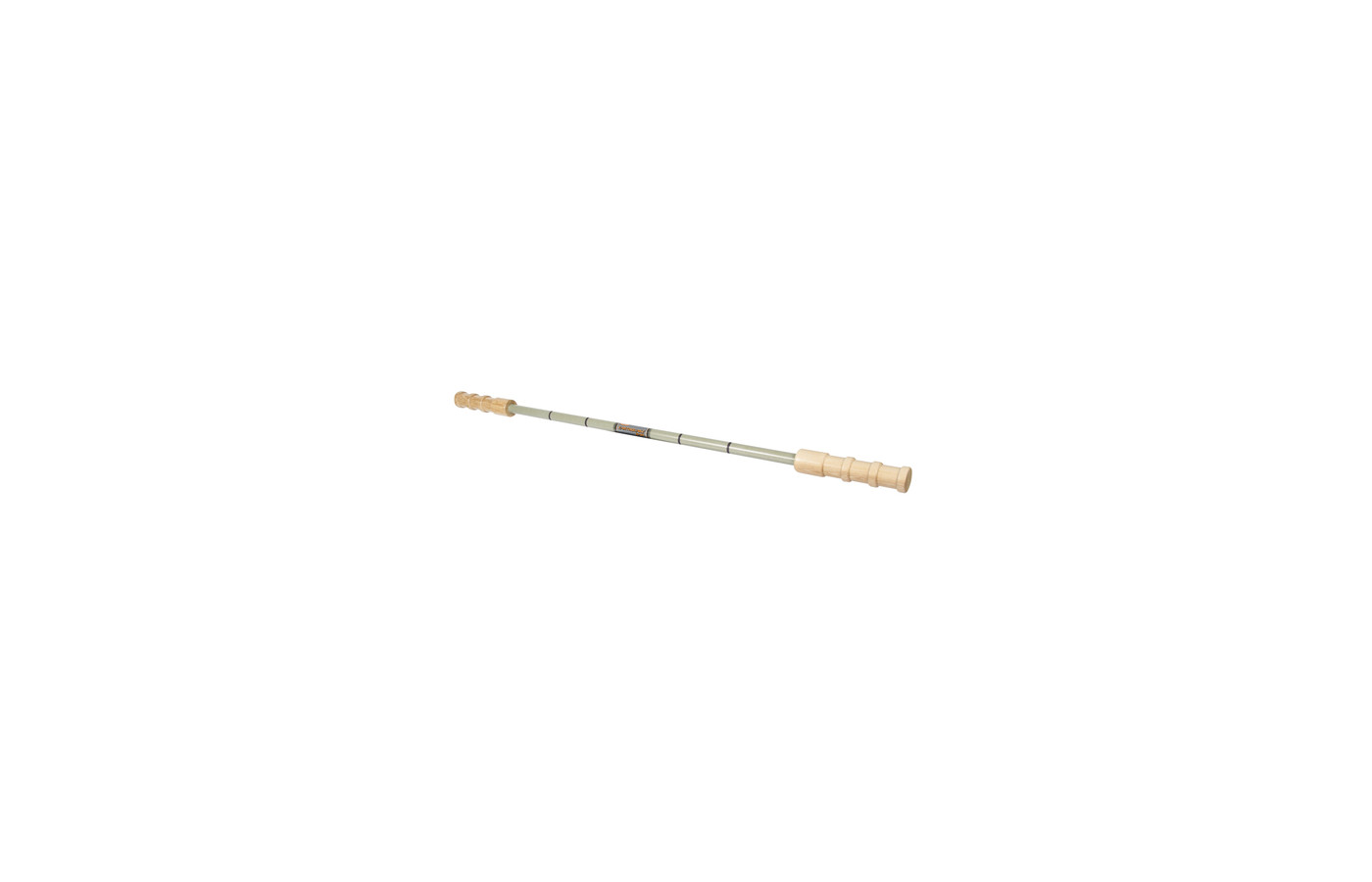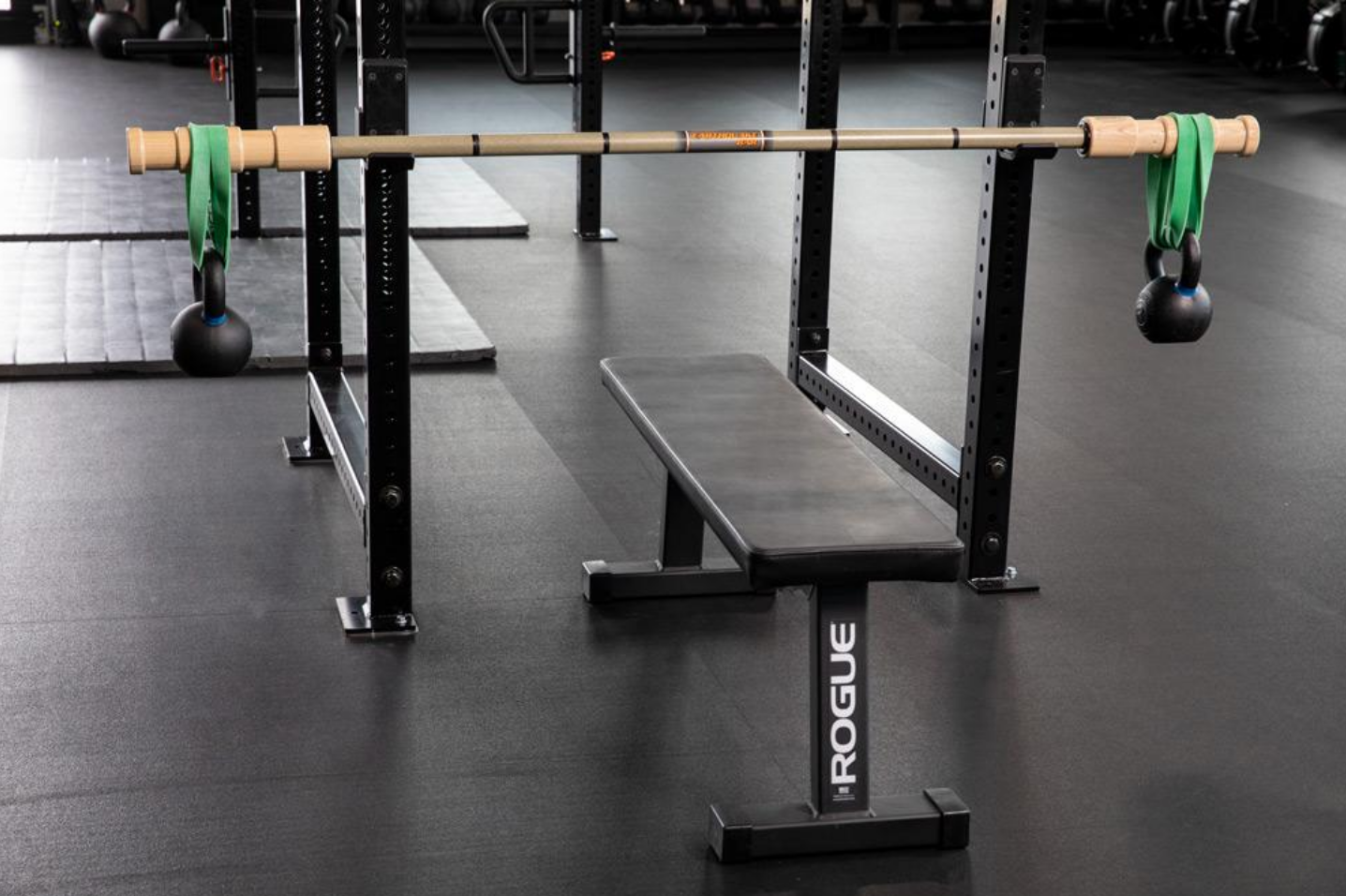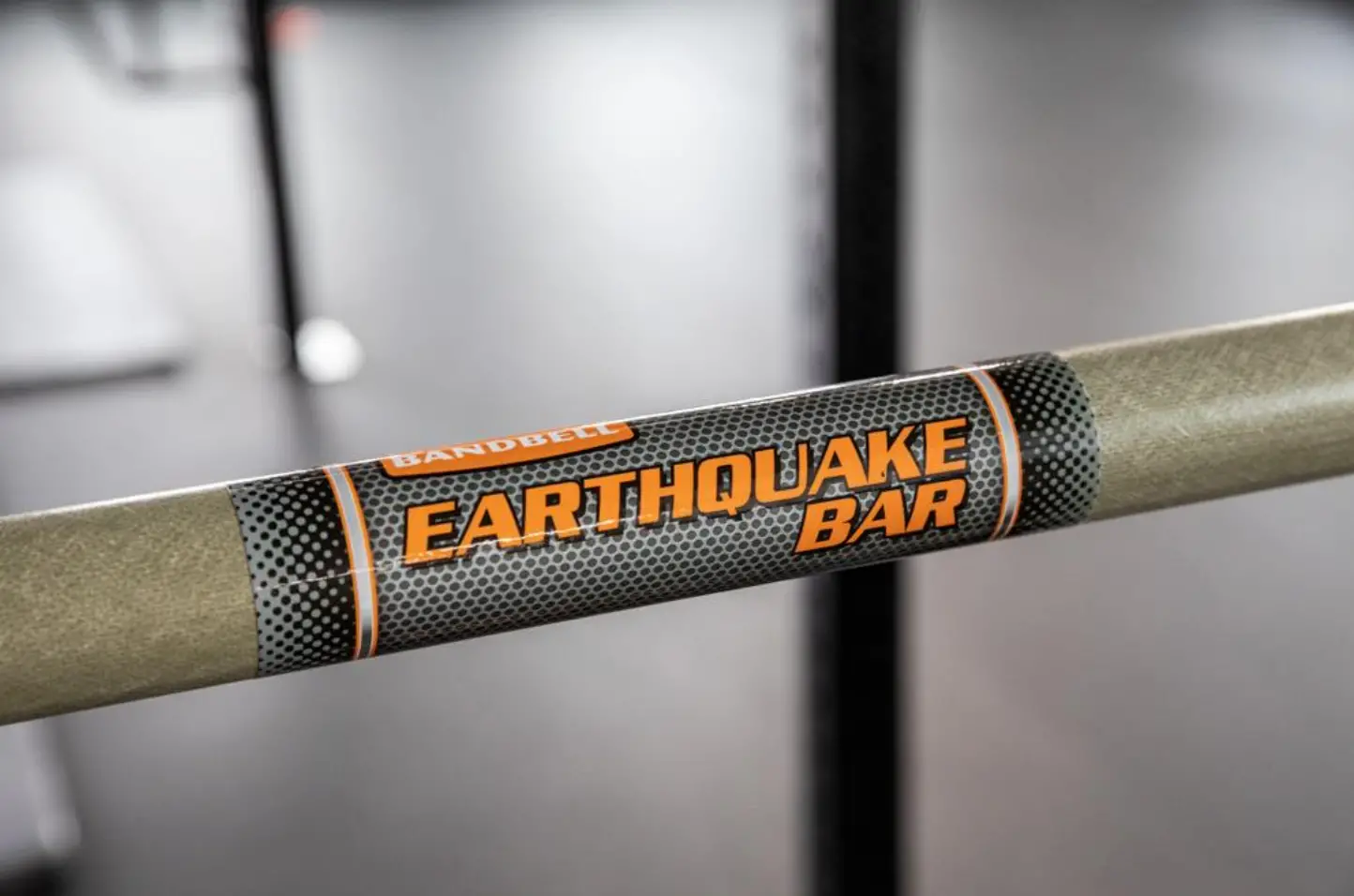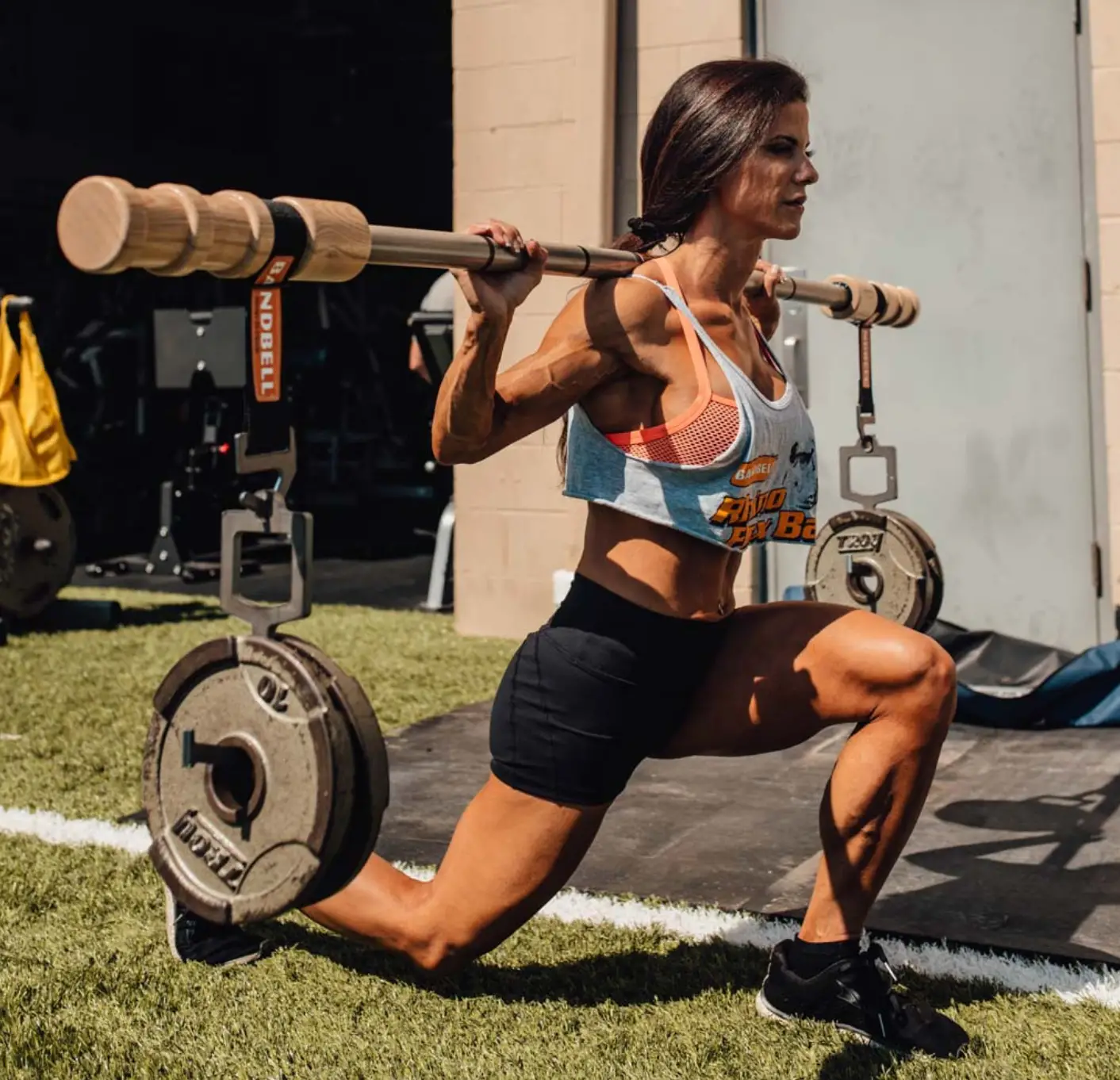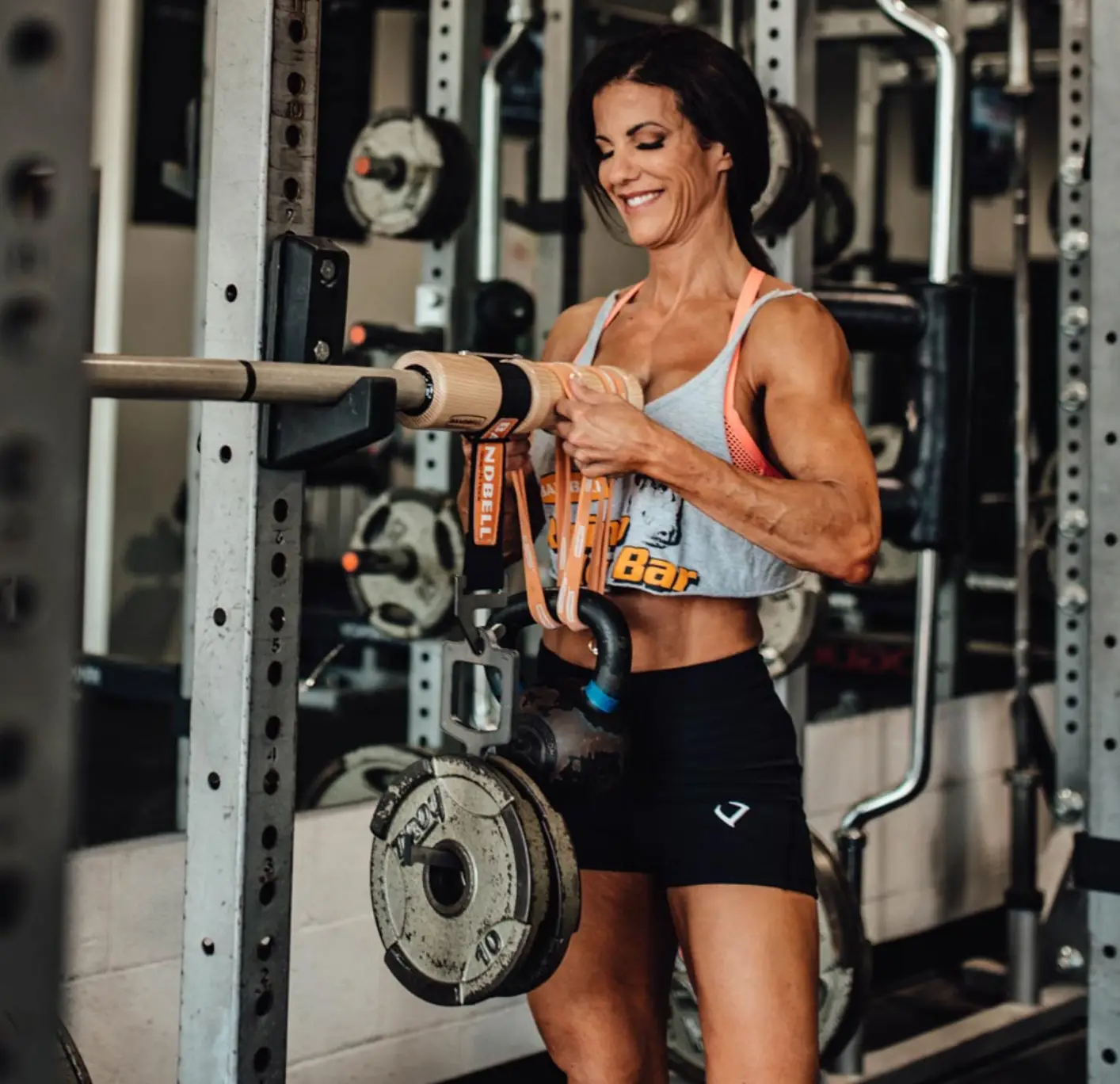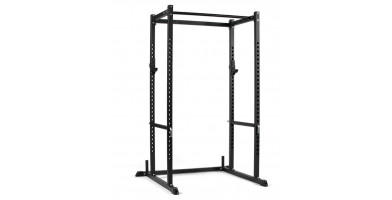Bandbell Earthquake Bar
Editor’s Conclusion
The Bandbell Earthquake Bar isn’t your average barbell. What makes this barbell unique is that it works to improve all of those tricky stability muscles, and locks you into your groove.
I once had to take a few months off from bench pressing, and it took me weeks to lock myself into proper form again.
By using this type of barbell, it helped me naturally guide my travel path back into that sweet spot for heavy lifts, and also strengthened my joints.
When you load kettlebells or plates to the bar via bands, the bar will want to swing around in your hands. To prevent this, you need to activate small stabilizing muscles to keep the bar steady.
It’s a great tool to use for cross-trainers that are always seeking out a new and unique challenge. It’s good for casual weightlifters that want to tone and sculpt, but it is a must-have for powerlifters.
There are few record-breaking powerlifters that don’t include resistance or OKE training into their schedule at least once a week.
Below, I wanted to take a deep dive into all of the advanced features that make the Bandbell Earthquake Bar a must-have for aspiring record-breaking powerlifters!
I once had to take a few months off from bench pressing, and it took me weeks to lock myself into proper form again.
By using this type of barbell, it helped me naturally guide my travel path back into that sweet spot for heavy lifts, and also strengthened my joints.
When you load kettlebells or plates to the bar via bands, the bar will want to swing around in your hands. To prevent this, you need to activate small stabilizing muscles to keep the bar steady.
It’s a great tool to use for cross-trainers that are always seeking out a new and unique challenge. It’s good for casual weightlifters that want to tone and sculpt, but it is a must-have for powerlifters.
There are few record-breaking powerlifters that don’t include resistance or OKE training into their schedule at least once a week.
Below, I wanted to take a deep dive into all of the advanced features that make the Bandbell Earthquake Bar a must-have for aspiring record-breaking powerlifters!
Bandbell Earthquake Bar Review Facts
Editor's Pros & Cons
Pros
Boasts a 300-pound weight capacity
Great for rehab work
Works small stabilizing muscles that straight bench presses can’t hit
Offers a unique challenge
Great for powerlifters or cross trainers
Can be used for squats, deadlifts, or bench presses
Cons
The lightweight bar is prone to tipping while loading
Expensive
Bands not included
Key Features
USE
You don’t load plates in the traditional way while using this bar. Instead, it requires users to loop kettlebells or plates through resistance bands, and then hang them off of the end of the bar.
When you lift the bar off of the rack, this movement will cause the kettlebells to naturally swing at the end of the bar. To prevent the bar from swaying, you will need to tighten all of your muscles in your upper body as well as engage all of the tiny stability muscles to lock the bar in place.
When you strengthen your stabilizing muscles, your straight bench presses will quickly improve. If you have hit the proverbial wall in your benches, this is an excellent tool that professional lifters use to knock out a new PR.
I talk a lot about using this bar for bench presses, but it’s also great for a wide variety of lifts as well. Whether you are powerlifting or cross-training, popping a few kettlebells on before engaging in compound lifts such as squats or deadlifts benefits your lifts much in the same way as bench presses.
I use this bar quite often to help improve the form of my squats, and it helps me to push heavier weights when working towards a new PR. For deadlifts, you will need to use a platform or a power rack to lift the bar up off of the floor to add your weights.
MATERIALS
Unlike traditional bars, this option is made from very lightweight materials. The ends are composed of hardened ash wood with small notches cut out to ensure that your bands stay firmly in place as you struggle under a set.
The bar is made from a composite resin that is much lighter than steel or iron, but incredibly durable. The reason why Bandbell utilizes resin over iron is to give this bar a good deal of whip.
Even under light weights, you can see the bar bend under the weight. With a higher level of whip, the bar is even more unstable- which is a good thing!
The bend in the bar may seem a bit unsettling as you lift, but as long as you stay within the recommended weight capacity of the bar, you can feel confident that the bar won’t snap under the pressure!
SIZE
It’s important to note that the measurements of this barbell are slightly different from an Olympic barbell.
This barbell measures to be 80 inches long, which is slightly shorter than 86-inch Olympic barbells. It’s a little shorter but will rack quite nicely on your rack.
It boasts a diameter of 1.5 inches, and the distance between collars is 54 inches. It’s just slightly different from your standard barbell, but it racks just the same.
ACCESSORIES
The downside of this bar is that the accessories needed are not included. If you don’t have a good set of resistance bands in your home gym, you will need to purchase them along with your bar.
Without bands, you essentially have a very long 6-pound paperweight. Bandbell offers specifically designed hooks and bands to mount your plates or kettlebells to the bar, but these straps are slightly expensive and can only be used for one purpose.
I recommend investing in a good set of resistance bands that work just as well as the Strap-n-Hooks.
You can use the resistance bands on your Earthquake bar, and also use them for various styles of resistance band training as well.
If you have a weight bench and rack, you most likely already have plates to use with this bar. You can either use a set of kettlebells or plates to add more weight to your bar.
I found that kettlebells are easier to hook around your bands to hang off of the bar, but not everyone has multiple pairs of kettlebells sitting around. While kettlebells are easier to mount, a pair of plates work just the same.
WEIGHT CAPACITY
Due to the lightweight frame of this bar, it is only able to accommodate up to 300 pounds. However, even seasoned powerlifters that are built like a tank have a lot of difficulties knocking out one rep at 300 pounds!
Overall, you are looking to achieve higher reps with this bar rather than volume, so the weaker weight capacity isn’t much of an issue. For most powerlifters, you will find that the weight you need to add to see results is far from 300 pounds!
It is important to note, however, that the bar itself weighs just over 6 pounds. This lower weight is great for swapping the bar in and out but poses a bit of a challenge when it comes to loading it up with kettlebells or weights.
Some users found that this bar is prone to tipping when loading it up with weights. It requires two users to add the weight to each side at the same time.
If you are working out alone, be sure that you carefully add the weight to each side while holding the bar down to prevent tipping.
GRIP
The size of the bar is the standard width of most barbells, but it lacks that classic knurling that helps to lock your hands in place.
This lack of knurling isn’t an oversight - it serves a very important function. At no point in the lift should you ever feel locked in and comfortable.
This is a bar that should always leave you teetering on the edge of a fallout. The slightly slick grip requires your hands and forearms to work overtime to keep that bar locked in place in your hands.
It may seem uncomfortable and awkward, but it is designed to make your straight bench presses feel that much better.
PRICE
I have to be honest, I was a little disappointed at the steep price point of this bar. It comes in at a price point that rivals high-end bars such as the Ohio Bar.
Plus, it requires the purchase of additional accessories (such as resistance bands), which means that you can’t use it right out of the box if you don’t have the right accessories on hand and also adds to the overall cost.
However, when you take into consideration how effective this bar is at improving your stability, joint health, and overall performance, it is well worth every penny!
There are quite a few “Earthquake bar hacks” that show you how to make your own Earthquake bar at home which is highly advised against!
Many of these homemade bars utilize materials that aren’t built to withstand heavy weights, and you run the risk of injuring yourself if and when the homemade bar snaps in your hand.
Sure, the Earthquake bar comes in at a high price point, but it also comes with a lifetime guarantee and you can feel confident loading up the bar safely with heavy weight.
You don’t load plates in the traditional way while using this bar. Instead, it requires users to loop kettlebells or plates through resistance bands, and then hang them off of the end of the bar.
When you lift the bar off of the rack, this movement will cause the kettlebells to naturally swing at the end of the bar. To prevent the bar from swaying, you will need to tighten all of your muscles in your upper body as well as engage all of the tiny stability muscles to lock the bar in place.
When you strengthen your stabilizing muscles, your straight bench presses will quickly improve. If you have hit the proverbial wall in your benches, this is an excellent tool that professional lifters use to knock out a new PR.
I talk a lot about using this bar for bench presses, but it’s also great for a wide variety of lifts as well. Whether you are powerlifting or cross-training, popping a few kettlebells on before engaging in compound lifts such as squats or deadlifts benefits your lifts much in the same way as bench presses.
I use this bar quite often to help improve the form of my squats, and it helps me to push heavier weights when working towards a new PR. For deadlifts, you will need to use a platform or a power rack to lift the bar up off of the floor to add your weights.
MATERIALS
Unlike traditional bars, this option is made from very lightweight materials. The ends are composed of hardened ash wood with small notches cut out to ensure that your bands stay firmly in place as you struggle under a set.
The bar is made from a composite resin that is much lighter than steel or iron, but incredibly durable. The reason why Bandbell utilizes resin over iron is to give this bar a good deal of whip.
Even under light weights, you can see the bar bend under the weight. With a higher level of whip, the bar is even more unstable- which is a good thing!
The bend in the bar may seem a bit unsettling as you lift, but as long as you stay within the recommended weight capacity of the bar, you can feel confident that the bar won’t snap under the pressure!
SIZE
It’s important to note that the measurements of this barbell are slightly different from an Olympic barbell.
This barbell measures to be 80 inches long, which is slightly shorter than 86-inch Olympic barbells. It’s a little shorter but will rack quite nicely on your rack.
It boasts a diameter of 1.5 inches, and the distance between collars is 54 inches. It’s just slightly different from your standard barbell, but it racks just the same.
ACCESSORIES
The downside of this bar is that the accessories needed are not included. If you don’t have a good set of resistance bands in your home gym, you will need to purchase them along with your bar.
Without bands, you essentially have a very long 6-pound paperweight. Bandbell offers specifically designed hooks and bands to mount your plates or kettlebells to the bar, but these straps are slightly expensive and can only be used for one purpose.
I recommend investing in a good set of resistance bands that work just as well as the Strap-n-Hooks.
You can use the resistance bands on your Earthquake bar, and also use them for various styles of resistance band training as well.
If you have a weight bench and rack, you most likely already have plates to use with this bar. You can either use a set of kettlebells or plates to add more weight to your bar.
I found that kettlebells are easier to hook around your bands to hang off of the bar, but not everyone has multiple pairs of kettlebells sitting around. While kettlebells are easier to mount, a pair of plates work just the same.
WEIGHT CAPACITY
Due to the lightweight frame of this bar, it is only able to accommodate up to 300 pounds. However, even seasoned powerlifters that are built like a tank have a lot of difficulties knocking out one rep at 300 pounds!
Overall, you are looking to achieve higher reps with this bar rather than volume, so the weaker weight capacity isn’t much of an issue. For most powerlifters, you will find that the weight you need to add to see results is far from 300 pounds!
It is important to note, however, that the bar itself weighs just over 6 pounds. This lower weight is great for swapping the bar in and out but poses a bit of a challenge when it comes to loading it up with kettlebells or weights.
Some users found that this bar is prone to tipping when loading it up with weights. It requires two users to add the weight to each side at the same time.
If you are working out alone, be sure that you carefully add the weight to each side while holding the bar down to prevent tipping.
GRIP
The size of the bar is the standard width of most barbells, but it lacks that classic knurling that helps to lock your hands in place.
This lack of knurling isn’t an oversight - it serves a very important function. At no point in the lift should you ever feel locked in and comfortable.
This is a bar that should always leave you teetering on the edge of a fallout. The slightly slick grip requires your hands and forearms to work overtime to keep that bar locked in place in your hands.
It may seem uncomfortable and awkward, but it is designed to make your straight bench presses feel that much better.
PRICE
I have to be honest, I was a little disappointed at the steep price point of this bar. It comes in at a price point that rivals high-end bars such as the Ohio Bar.
Plus, it requires the purchase of additional accessories (such as resistance bands), which means that you can’t use it right out of the box if you don’t have the right accessories on hand and also adds to the overall cost.
However, when you take into consideration how effective this bar is at improving your stability, joint health, and overall performance, it is well worth every penny!
There are quite a few “Earthquake bar hacks” that show you how to make your own Earthquake bar at home which is highly advised against!
Many of these homemade bars utilize materials that aren’t built to withstand heavy weights, and you run the risk of injuring yourself if and when the homemade bar snaps in your hand.
Sure, the Earthquake bar comes in at a high price point, but it also comes with a lifetime guarantee and you can feel confident loading up the bar safely with heavy weight.
Verdict
I often wondered why this bar was called an “Earthquake” bar. Then, I watched someone knock out a set while using this bar and suddenly the name made sense. When you lift this bar, your arms shake as if you are lifting in the middle of an Earthquake!
For serious lifters, this bar is well worth the high price tag. It helps to improve your overall stability and control and helps increase flexibility and overall joint health.
If you have a certain sticking point in your lifts, this bar is designed to help strengthen your weak points to push past a PR wall.
Overall, I would recommend the Bandbell Earthquake Bar for dedicated powerlifters that are always on the hunt for new ways to increase their PR.
It’s also a great tool for cross-trainers or bodybuilders that want to sculpt muscle and improve endurance and overall joint health.
For serious lifters, this bar is well worth the high price tag. It helps to improve your overall stability and control and helps increase flexibility and overall joint health.
If you have a certain sticking point in your lifts, this bar is designed to help strengthen your weak points to push past a PR wall.
Overall, I would recommend the Bandbell Earthquake Bar for dedicated powerlifters that are always on the hunt for new ways to increase their PR.
It’s also a great tool for cross-trainers or bodybuilders that want to sculpt muscle and improve endurance and overall joint health.

